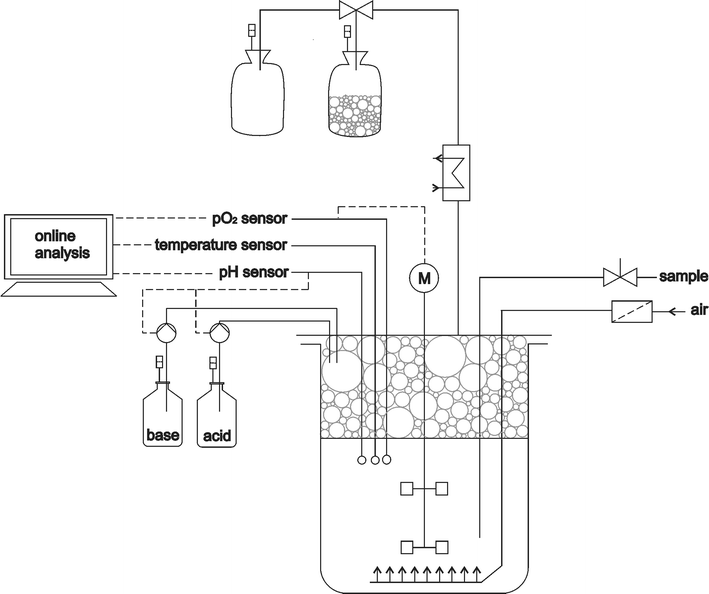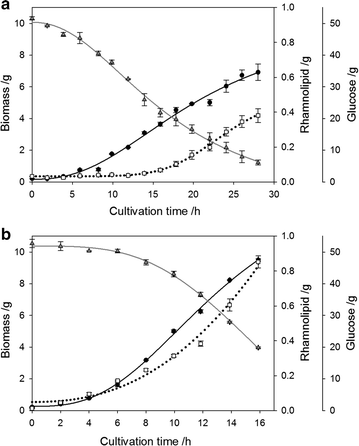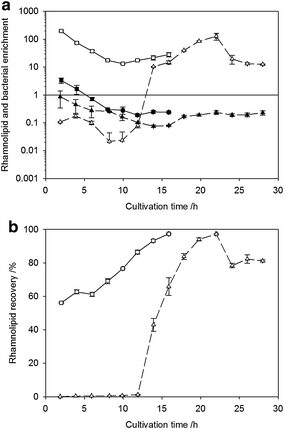Integrated foam fractionation for heterologous rhamnolipid production with recombinant Pseudomonas putida in a bioreactor
- PMID: 26860613
- PMCID: PMC4747948
- DOI: 10.1186/s13568-016-0183-2
Integrated foam fractionation for heterologous rhamnolipid production with recombinant Pseudomonas putida in a bioreactor
Abstract
Heterologeous production of rhamnolipids in Pseudomonas putida is characterized by advantages of a non-pathogenic host and avoidance of the native quorum sensing regulation in Pseudomonas aeruginosa. Yet, downstream processing is a major problem in rhamnolipid production and increases in complexity at low rhamnolipid titers and when using chemical foam control. This leaves the necessity of a simple concentrating and purification method. Foam fractionation is an elegant method for in situ product removal when producing microbial surfactants. However, up to now in situ foam fractionation is nearly exclusively reported for the production of surfactin with Bacillus subtilis. So far no cultivation integrated foam fractionation process for rhamnolipid production has been reported. This is probably due to excessive bacterial foam enrichment in that system. In this article a simple integrated foam fractionation process is reported for heterologous rhamnolipid production in a bioreactor with easily manageable bacterial foam enrichments. Rhamnolipids were highly concentrated in the foam during the cultivation process with enrichment factors up to 200. The described process was evaluated at different pH, media compositions and temperatures. Foam fractionation processes were characterized by calculating procedural parameter including rhamnolipid and bacterial enrichment, rhamnolipid recovery, YX/S, YP/X, and specific as well as volumetric productivities. Comparing foam fractionation parameters of the rhamnolipid process with the surfactin process a high effectiveness of the integrated foam fractionation for rhamnolipid production was demonstrated.
Keywords: Biosurfactant; Downstream processing; Foam fractionation; Heterologous rhamnolipid; In situ product removal (ISPR); Pseudomonas putida.
Figures



Similar articles
-
Production of rhamnolipids by integrated foam adsorption in a bioreactor system.AMB Express. 2018 Jul 24;8(1):122. doi: 10.1186/s13568-018-0651-y. AMB Express. 2018. PMID: 30043199 Free PMC article.
-
Genetic Cell-Surface Modification for Optimized Foam Fractionation.Front Bioeng Biotechnol. 2020 Oct 29;8:572892. doi: 10.3389/fbioe.2020.572892. eCollection 2020. Front Bioeng Biotechnol. 2020. PMID: 33195133 Free PMC article.
-
Uncoupling Foam Fractionation and Foam Adsorption for Enhanced Biosurfactant Synthesis and Recovery.Microorganisms. 2020 Dec 18;8(12):2029. doi: 10.3390/microorganisms8122029. Microorganisms. 2020. PMID: 33353027 Free PMC article.
-
Heterologous Rhamnolipid Biosynthesis: Advantages, Challenges, and the Opportunity to Produce Tailor-Made Rhamnolipids.Front Bioeng Biotechnol. 2020 Oct 22;8:594010. doi: 10.3389/fbioe.2020.594010. eCollection 2020. Front Bioeng Biotechnol. 2020. PMID: 33195161 Free PMC article. Review.
-
Rhamnolipids--next generation surfactants?J Biotechnol. 2012 Dec 31;162(4):366-80. doi: 10.1016/j.jbiotec.2012.05.022. Epub 2012 Jun 20. J Biotechnol. 2012. PMID: 22728388 Review.
Cited by
-
Heterologous rhamnolipid biosynthesis by P. putida KT2440 on bio-oil derived small organic acids and fractions.AMB Express. 2019 May 31;9(1):80. doi: 10.1186/s13568-019-0804-7. AMB Express. 2019. PMID: 31152276 Free PMC article.
-
Coupling an Electroactive Pseudomonas putida KT2440 with Bioelectrochemical Rhamnolipid Production.Microorganisms. 2020 Dec 10;8(12):1959. doi: 10.3390/microorganisms8121959. Microorganisms. 2020. PMID: 33322018 Free PMC article.
-
Surface-active antibiotic production as a multifunctional adaptation for postfire microorganisms.ISME J. 2024 Jan 8;18(1):wrae022. doi: 10.1093/ismejo/wrae022. ISME J. 2024. PMID: 38366029 Free PMC article.
-
In silico engineering of Pseudomonas metabolism reveals new biomarkers for increased biosurfactant production.PeerJ. 2018 Dec 17;6:e6046. doi: 10.7717/peerj.6046. eCollection 2018. PeerJ. 2018. PMID: 30588397 Free PMC article.
-
Designer rhamnolipids by reduction of congener diversity: production and characterization.Microb Cell Fact. 2017 Dec 14;16(1):225. doi: 10.1186/s12934-017-0838-y. Microb Cell Fact. 2017. PMID: 29241456 Free PMC article.
References
-
- Bergström S, Theorell H, Davide H. Pyolipic acid, a metabolic product of Pseudomonas pyocyanea, active against Mycobacterium tuberculosis. Ark Kemi Miner Och Geol. 1946;23A:1–12.
-
- Chandrasekaran EV, Bemiller JN. Constituent analyses of glycosaminoglycans. In: Whistler RL, Bemiller JN, editors. Methods in carbohydrate chemistry. New York: Academic Press Inc; 1980. p. 372.
LinkOut - more resources
Full Text Sources
Other Literature Sources

